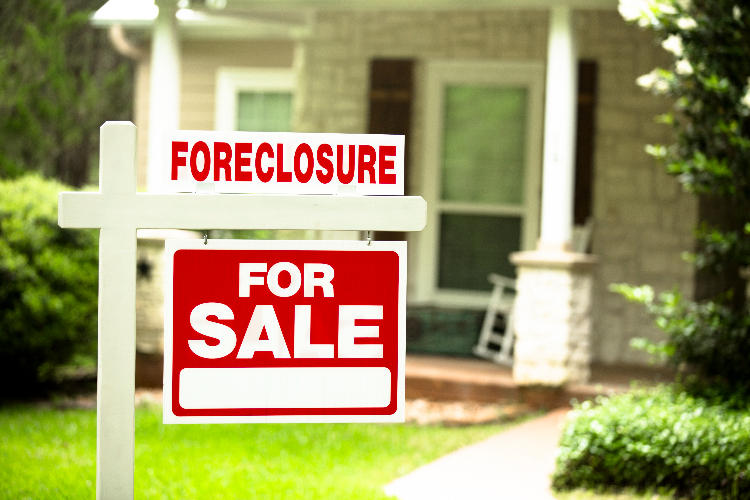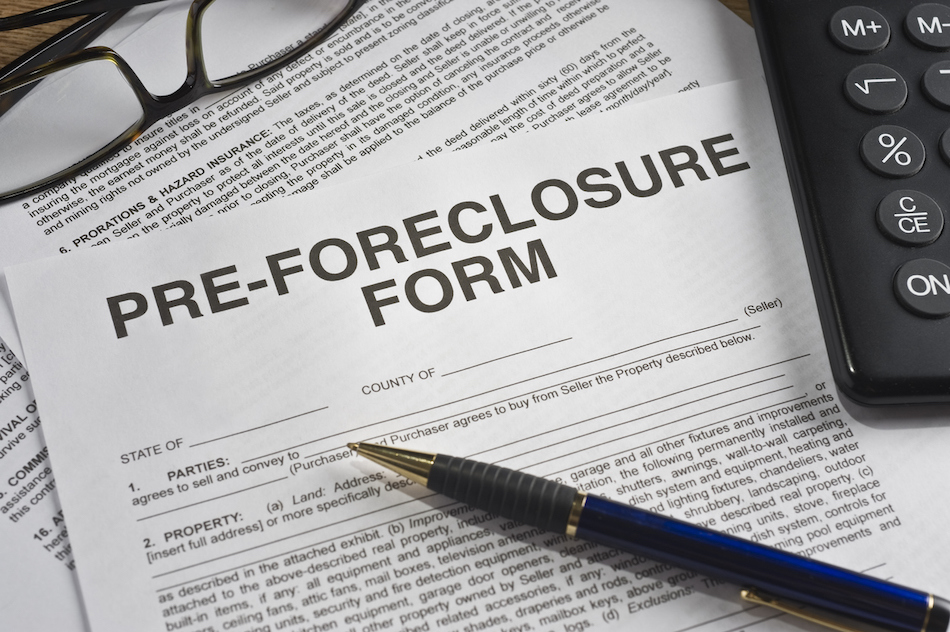During the Great Recession of 2007-2010, there were approximately 3.8 million foreclosures created by the extreme decline of the housing market and resulting financial crisis, according to the Federal Reserve Bank of Chicago.
While there’s no guarantee that history will repeat itself, some homeowners and investors alike are beginning to wonder if real estate foreclosures will once again begin to rise.
In this article, we’ll explain what pre-foreclosure in real estate is, how it works, ways homeowners may be able to avoid foreclosure, and the potential investment opportunities of buying a pre-foreclosure home.
Key takeaways
- Pre-foreclosure in real estate occurs when a borrower has stopped paying the mortgage.
- During pre-foreclosure a borrower may become current on the mortgage, try to make payment arrangements with a lender, or sell the property pre-foreclosure.
- Potential advantages to buying a pre-foreclosure property for an investor include acquiring a home not officially listed for sale at a below market price.
What is pre-foreclosure in real estate?
Pre-foreclosure is the beginning of the legal process a lender uses to foreclose – or take back – a home that a borrower has stopped paying the mortgage on.
A homeowner who receives a pre-foreclosure notice may still have options available, such as:
- Catching up on the past due payments, including any penalties and fees.
- Making payment arrangements with a lender, which is also known as a work out or mortgage forbearance.
- Selling the property before the foreclosure is final and the homeowner is evicted.
How pre-foreclosure works
The pre-foreclosure process begins when a borrower misses a monthly mortgage payment. There are three main steps in real estate foreclosure:
1. Default
Typically, a borrower goes into default when 3 consecutive monthly mortgage payments are missed, which means a borrower is 90 days in arrears. If a borrower is struggling financially, a lender may be willing to agree to forbearance for a limited time.
As the Consumer Financial Protection Bureau (CFPB) explains, forbearance is when a mortgage servicer or lender temporarily pauses or reduces mortgage payments until a borrower can improve his or her financial situation.
2. Notice of defaultA notice of default is a written notice sent by a lender to a borrower indicating that a home is in pre-foreclosure and that legal action will be taken if the past due debt is not paid.
In most cases, a lender will wait 3-6 months before sending a notice of default and beginning the pre-foreclosure process. The entire process may take 3-10 months from start to finish, depending on the state the home is located in.
In addition to sending a notice of default, a lender will also record a public notice with the County Recorder that the home is in pre-foreclosure, which is information that anyone accessing the Recorder’s website can see. The notice of default also gives a lender the right to file a lawsuit with the court if a tenant becomes current on the debt.
3. Foreclosure saleIf a borrower does not respond to the notice of default or is unable to reach a forbearance agreement with the lender, the lender will foreclose on the home. Depending on the state law where the property is located, a lender may:
- Initiate a judicial foreclosure through the court system.
- Execute a deed of trust, which is also known as a non-judicial foreclosure.
Once a property is foreclosed on, a lender will often sell the home at an auction or trustee sale to the highest bidder. A lender will generally set a minimum or floor bid for at least the amount of principal owed on the loan.

What can a homeowner do during pre-foreclosure?
There are several steps a homeowner can take to avoid losing a property due to foreclosure and being evicted.
1. Become current on the past due balanceA lender may agree to stop the foreclosure process when a borrower becomes current on all missed mortgage payments, including any fees and penalties. A borrower may be able to borrow money from family or friends to catch up on missed payments.
Even though a borrower is adding on additional debt, borrowing more to stop a foreclosure may be a better option than losing a home, being evicted, and having a foreclosure on a credit report.
2. Ask the lender for forbearanceMortgage forbearance is when a lender pauses or reduces a borrower’s mortgage payments for a limited amount of time. While the payments owed do not go away, a forbearance may provide a borrower with enough time to get back on their feet.
Generally speaking, payments placed on hold during forbearance will need to be repaid, either in a lump sum or over time, depending upon the agreement with the lender.
3. Negotiate a loan modificationA loan modification permanently alters the original terms of a loan, such as reducing the interest rate, changing the mortgage from an adjustable to fixed interest rate, or modifying the term length to give a borrower more time to repay a loan.
To modify a loan, a borrower usually needs to provide a lender with proof of income, the most recent tax return, bank and financial statements to confirm the amount of a borrower’s assets, and a hardship letter explaining to a lender why the existing mortgage payment amount can no longer be paid on time.
There are many companies that offer to provide loan modification services to borrowers who are behind in their payments. However, law enforcement agencies warn that some of these companies are illegitimate. Generally, federal laws prohibit loan modification providers from charging an upfront fee. Instead, they are allowed to collect their fee only after a modification has been procured.
4. Consider refinancingInstead of modifying an existing loan, a borrower may be able to refinance and replace the current mortgage loan with an entirely new loan.
Some of the potential benefits of refinancing include changing the loan type (such as from FHA to conventional), lengthening or shortening the repayment term of the loan, or locking in a lower interest rate. Refinancing an existing mortgage to avoid foreclosure may be an attractive option for a borrower who has equity in the property and is not upside down on the mortgage.
5. Attempt a short saleA short sale occurs when a lender agrees to allow a borrower to sell the home for less than the outstanding balance on the mortgage. While a lender may lose money with a short sale, a lender also saves on the time and cost of foreclosing on the property.
A buyer’s offer to purchase a short sale for less than the mortgage owed must be approved by the lender before the sale transaction can be completed.
6. Ask for a deed in lieu of foreclosureAlso known as “giving back the keys,” a deed in lieu of foreclosure may be an option for a borrower who wants to avoid being foreclosed on and evicted.
In exchange for a borrower giving back a property to a lender, a lender will agree to forgive the outstanding mortgage debt. In some cases, a borrower may still be required to reimburse a lender for any losses, and a borrower may still receive a negative mark on their credit report.
Buying a pre-foreclosure home
A pre-foreclosure home may offer an investor the opportunity to find an off market deal at a below market price. While there’s no guarantee that a lender will agree to a sale for less than what the home is worth, it may still be worth the time and effort spent to buy a pre-foreclosure home.
Here are the general steps to follow to find and buy a home that is going into foreclosure:
1. Search for pre-foreclosure properties.Good ways to find a property owner who needs to sell fast include asking a real estate agent to search the MLS for pre-foreclosure listings, or looking online on websites such as Zillow for pre-foreclosures.
2. Research the neighborhood a pre-foreclosure home is located in.An in-depth analysis should provide a better idea of the fair market value of the pre-foreclosure home, rent price growth trends, median income levels, school district quality, and overall neighborhood rating.
3. Conduct preliminary due diligence by looking at the condition of the property.A pre-foreclosure home may have a significant amount of deferred maintenance, and a buyer will need to accurately estimate the cost of any needed repairs and the after repair value or ARV.
4. Determine the outstanding mortgage balance along with any other property liens (such as a tax lien), and raise cash or arrange short-term financing to help make a strong offer to a homeowner and lender.
5. Contact the homeowner to discuss a possible sale of the property, and meet in-person at the property if possible.
An owner facing foreclosure may be under a large amount of stress, so solid negotiating skills will be required. Try to identify seller hot-buttons, such as allowing the owner to stay in the home a month or so after closing, or even to rent-back the home at a fair market rent.
6. Draw up and sign a purchase and sale agreement after agreeing to a price and contract terms and conditions, and open escrow at a local title company.At this point, a buyer may wish to work with a real estate agent or real estate attorney with experience in short sales or foreclosure transactions. If a home is being sold for less than the mortgage balance due, lender approval will be needed before the home can be sold.
A buyer will normally include contingencies in the contract allowing for a complete professional property inspection, appraisal (even if the deal is for all cash), and a full title search to identify all liens on the property.
7. Close escrow and take possession of the property.Once all contract contingencies have been removed, a title company or real estate attorney will handle the transfer of funds, ensure that the mortgage is paid in full along with any other liens, and that a new deed is properly recorded.
Closing thoughts
In most cases, a pre-foreclosure can be solved by becoming current on any past due mortgage payments, asking a lender for forbearance, loan modification, or refinancing.
A borrower facing pre-foreclosure may also have the opportunity to eliminate unnecessary stress by selling a home to a real estate investor willing to make a fair offer. Buying and selling a pre-foreclosure property can be complicated, but it may also be worth the time and effort for a seller to get out of debt and a buyer to make an attractive investment.









